Blending florals and herbs creates a richer tea experience, combining unique flavors and health benefits. Florals like chamomile and hibiscus offer sweetness and aroma, while herbs like peppermint and ginger provide depth and invigorating qualities. This mix not only enhances taste but also supports your wellness goals—think chamomile for relaxation or ginger for an immunity boost. You can experiment with different ratios to discover your perfect blend, making the process both creative and mindful. There's so much more to explore about flavor pairings and preparation techniques that can elevate your tea to the next level.
Benefits of Floral and Herb Blends
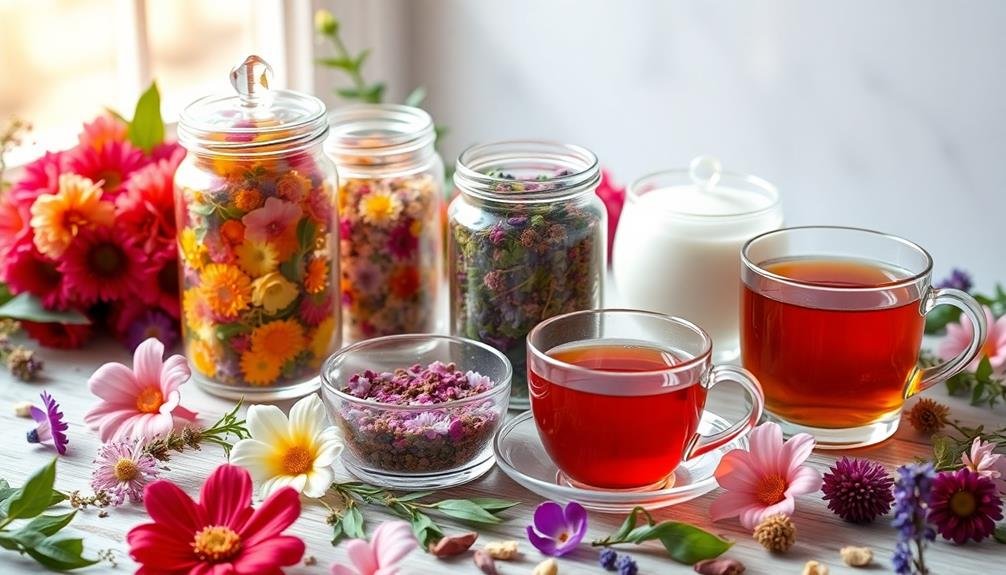
When you blend florals and herbs for tea, you open up a world of benefits that can enhance both your well-being and your palate. Combining these ingredients creates a unique flavor profile, allowing you to explore new taste dimensions.
You'll find that florals add a hint of sweetness and aroma, while herbs provide depth and earthiness. This balance can elevate your tea experience, making each cup more enjoyable.
Additionally, many floral and herb blends offer health benefits. For instance, chamomile can promote relaxation, while peppermint aids digestion. By mixing these elements, you can tailor your brew to suit your mood or health needs.
Feeling stressed? A lavender and chamomile blend might be perfect for you. Need a pick-me-up? Try a combination of hibiscus and ginger.
Moreover, blending allows for creativity. You can experiment with different ratios to find what you love most. This not only keeps your tea routine exciting, but it also encourages mindfulness as you savor each sip.
Popular Floral Ingredients
Florals play an essential role in tea blends, offering both flavor and fragrance that can elevate your experience. When you think about popular floral ingredients, several come to mind, each contributing unique characteristics to your brew.
One of the most beloved is chamomile. Its sweet, apple-like flavor creates a soothing cup that's perfect for winding down.
If you're after something more aromatic, lavender is a fantastic choice. Its calming scent and slightly herbal taste can transform your tea into a fragrant escape.
Hibiscus is another popular option, known for its tartness and vibrant red hue. It adds a revitalizing zing, making it ideal for iced teas.
Jasmine offers a delicate floral note, often paired with green or white teas for a fragrant and uplifting experience.
Roses are also commonly used, bringing a romantic touch and a subtle sweetness that can balance out stronger flavors.
Marigold petals add a splash of color and a mild, slightly spicy taste.
Common Herb Choices
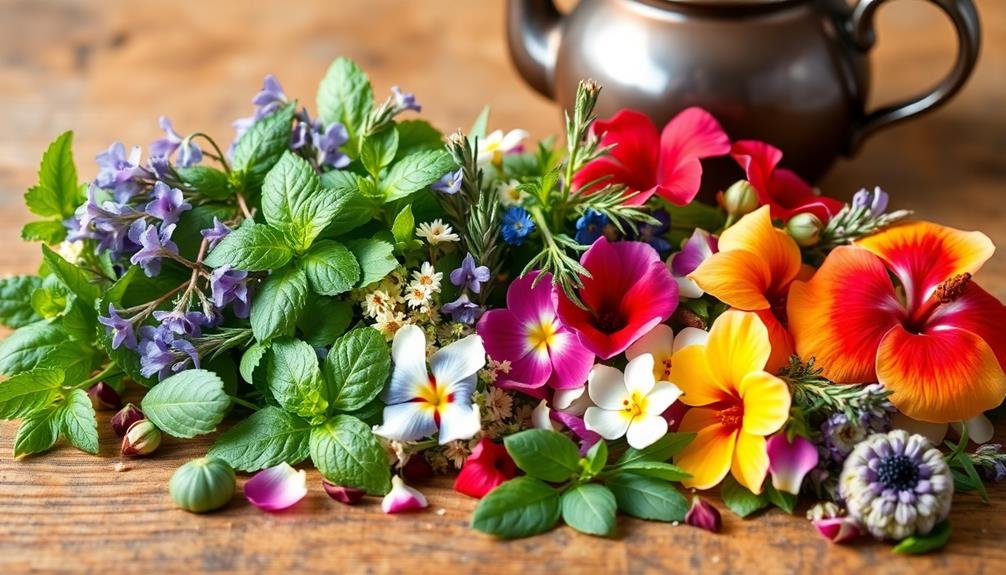
When you're choosing herbs for your tea blends, certain selections stand out for their flavor and benefits.
Popular options like mint, chamomile, and lavender can enhance your brew in delightful ways.
Let's explore how these herbs can elevate your tea experience.
Popular Herbal Selections
Herbal teas offer a delightful variety of flavors and health benefits, making them a popular choice among tea enthusiasts. When you're exploring herb selections, consider these crowd favorites:
- Peppermint: Known for its invigorating taste, peppermint can help with digestion and provide a cooling sensation.
- Chamomile: This gentle herb is perfect for relaxation and may assist with sleep, making it a soothing choice for nighttime.
- Ginger: With its spicy kick, ginger is excellent for boosting immunity and alleviating nausea.
- Lemon Balm: This herb delivers a mild lemon flavor and is recognized for its calming properties, perfect for reducing stress.
These herbs not only enhance the aroma and flavor of your tea but also contribute various health benefits.
By blending them creatively, you can tailor your tea experience to suit your mood and wellness goals.
Don't hesitate to experiment with different combinations to discover your perfect blend! Each herb brings something unique to the table, ensuring every cup is an adventure in taste and health.
Happy brewing!
Flavor Enhancement Techniques
A variety of flavor enhancement techniques can transform your tea experience and elevate your enjoyment. By incorporating common herbs into your blends, you can create unique and delightful flavors that cater to your taste preferences. Here are some popular herb choices and their flavor profiles:
| Herb | Flavor Profile |
|---|---|
| Peppermint | Cool, invigorating, minty |
| Chamomile | Sweet, floral, calming |
| Ginger | Spicy, warm, invigorating |
| Lemongrass | Citrusy, fresh, zesty |
| Lavender | Sweet, floral, soothing |
When you experiment with these herbs, consider how they interact with your chosen florals. Peppermint pairs wonderfully with chamomile for a soothing yet invigorating blend. Ginger adds a kick to floral teas, making them vibrant and lively. Lemongrass can brighten up more robust flavors, while lavender's aromatic essence brings a touch of tranquility to any mix.
As you play around with these combinations, you'll discover the perfect balance that enhances your tea's flavor, elevating your overall tea-drinking experience to new heights. Enjoy the journey of flavor exploration!
Ideal Blending Ratios
Finding the right blending ratios can make all the difference in creating a harmonious tea. Achieving the perfect balance between florals and herbs guarantees that your brew is both flavorful and aromatic.
While everyone's taste preferences vary, here are some general guidelines to get you started:
- 1 part herb to 1 part floral: This ratio works well when you want a balanced flavor.
- 2 parts herb to 1 part floral: Use this for a more robust, herb-forward tea.
- 1 part herb to 2 parts floral: This is ideal when you want the floral notes to shine through.
- Experiment with ratios: Don't hesitate to adjust based on personal preference or the specific herbs and florals you're using.
Keep in mind that some herbs can be stronger than others, and certain florals may have a more delicate flavor.
Start with small batches and take notes on what works best for you. With practice, you'll discover the ideal blending ratios that create your signature tea blend, bringing out the best in both florals and herbs.
Enjoy the journey of finding your perfect balance!
Techniques for Blending
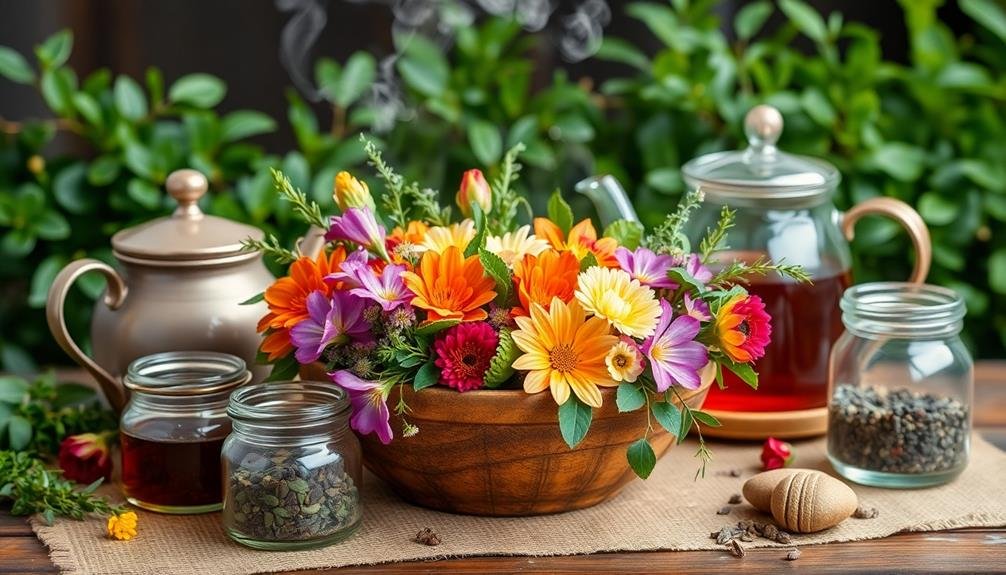
Crafting your own tea blend is an art that requires both creativity and technique. Start by selecting your base ingredients. Choose a primary herb or floral that will serve as the foundation of your blend, such as chamomile or peppermint.
Then, think about complementary flavors. Consider how different herbs and florals interact; for example, pairing lavender with lemon balm can create a soothing effect.
Next, pay attention to texture. Crush or chop larger leaves to release their essential oils, enhancing the overall aroma and flavor. Use a mortar and pestle for this task; it helps to break down the ingredients while keeping them intact.
When blending, mix small batches first. This way, you can experiment without committing to a large quantity.
Don't forget to combine dry ingredients evenly. You can use a small bowl to mix them thoroughly, ensuring a balanced distribution of flavors.
Finally, let your blend sit for a few days. This resting period allows the flavors to meld and develop, giving you a more cohesive tea experience.
Enjoy your exploration of blending techniques, and don't hesitate to adjust your ratios as you discover what works best for your palate!
Flavor Profiles to Explore
When creating your tea blends, think about how complementary flavors can enhance your experience.
Balancing sweet and savory notes can transform your brew, making it more dynamic and interesting.
Plus, don't forget to draw inspiration from seasonal ingredients to keep your blends fresh and exciting.
Complementary Flavor Combinations
Have you ever wondered how to create the perfect balance of flavors in your herbal teas? Blending florals and herbs can elevate your tea experience, and exploring complementary flavor combinations is key.
By understanding which flavors work well together, you can craft unique blends that excite your palate.
Here are some complementary flavor combinations to contemplate:
- Chamomile and Lavender: Both offer calming notes, perfect for bedtime.
- Peppermint and Lemon Balm: The invigorating mint pairs beautifully with the subtle citrus.
- Hibiscus and Rose: The tartness of hibiscus balances the sweetness of rose.
- Echinacea and Lemon Verbena: This combo brings together earthy and citrusy notes for a revitalizing boost.
Experimenting with these pairings can help you discover new favorites.
Don't be afraid to try different ratios until you find the blend that suits your taste.
With each cup, you'll gain insight into how the flavors interact, making your tea-drinking experience even more enjoyable.
Balancing Sweet and Savory
Exploring the art of blending florals and herbs opens up exciting possibilities, especially when you start to balance sweet and savory flavors.
Think about how the sweetness of chamomile or hibiscus can complement the earthiness of rosemary or thyme. This balance creates a complex profile that tantalizes your taste buds.
To achieve this harmony, consider using ingredients like lavender, which offers a light sweetness, paired with a touch of sage for its savory depth.
You might also blend peppermint's invigorating sweetness with a hint of oregano, creating an unexpected yet delightful combination. Experimenting with these pairings can lead to unique teas that awaken your senses.
Don't shy away from trying unexpected combinations. A floral like jasmine can add floral notes while mixing with a savory herb like basil can produce a tea that's both invigorating and grounding.
The key is to find the right proportions; too much sweetness can overwhelm the palate, while too much savory can overshadow delicate floral notes.
Seasonal Ingredient Inspirations
What seasonal ingredients are you excited to incorporate into your tea blends? Each season brings a unique array of flavors that can elevate your tea experience. Embracing these seasonal ingredients not only enhances the taste but also connects you to nature's rhythm.
Here are some fantastic flavor profiles to explore:
- Spring: Fresh mint, vibrant chamomile flowers, and zesty citrus peel create a revitalizing blend.
- Summer: Juicy berries, fragrant lavender, and cooling cucumber offer a delightful balance of sweetness and floral notes.
- Autumn: Spicy cinnamon, earthy ginger, and crisp apples bring warmth and comfort to your tea.
- Winter: Bold chai spices, comforting vanilla, and soothing chamomile can create a cozy, inviting cup.
As you experiment with these seasonal ingredients, consider the flavor combinations that resonate with you.
By blending florals and herbs that reflect the season, you'll craft unique teas that celebrate the essence of each time of year.
Storing Your Tea Blends
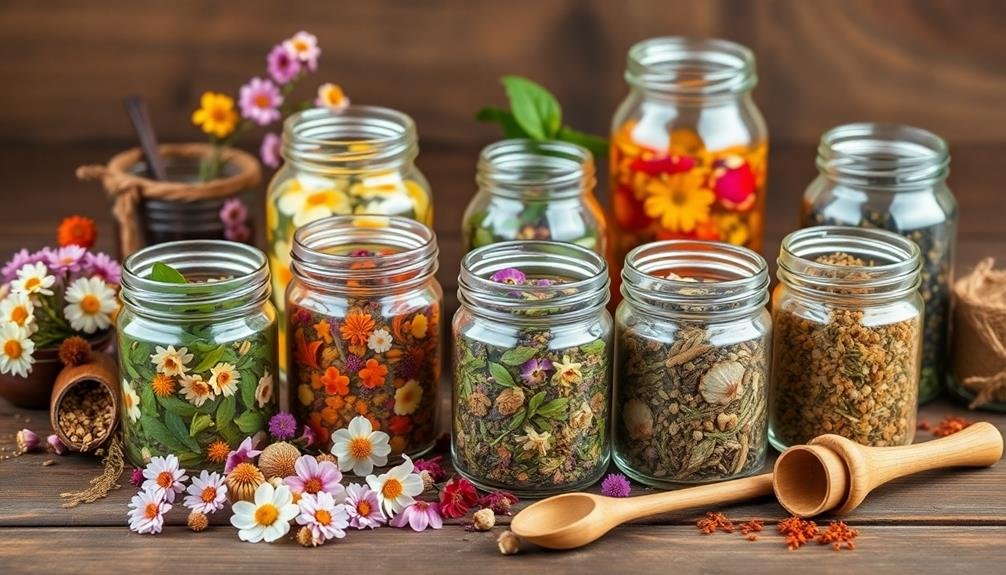
Your tea blends deserve proper storage to maintain their fresh flavors and aromas. To achieve this, start by choosing airtight containers. Glass jars with tight-sealing lids or metal tins work well, as they prevent exposure to air, light, and moisture—all enemies of your precious blends.
Next, keep your containers in a cool, dark place. Avoid areas near heat sources like stoves or sunny windows. Excess heat and light can degrade the quality of your herbs and florals, leading to loss of potency. A pantry or cupboard is usually ideal for storage.
Label your containers with the blend name and the date you made it. This helps you keep track of freshness. Most blends stay vibrant for six months to a year, but some may last longer depending on the ingredients used.
Frequently Asked Questions
Can I Use Dried Flowers and Herbs for Blending Tea?
Absolutely, you can use dried flowers and herbs for blending tea! They add unique flavors and aromas, enhancing your tea experience. Just make sure they're safe for consumption and complement each other well for the best results.
How Long Can I Store My Tea Blends?
You can store your tea blends for about six months to a year if kept in a cool, dark place in an airtight container. Just remember to check for freshness before brewing your next cup!
Are There Any Floral or Herb Allergies to Consider?
Yes, you should consider potential allergies when choosing floral or herbal ingredients. Common allergens include chamomile and hibiscus. Always check with a healthcare professional if you're unsure about specific herbs or flowers you're planning to use.
Can I Blend Floral and Herb Teas With Fruits?
Absolutely, you can blend floral and herb teas with fruits! Experimenting with different combinations enhances flavors and aromas. Just remember to balance the sweetness of the fruit with the delicate notes of the herbs and florals.
What Equipment Do I Need for Blending Teas at Home?
To blend teas at home, you'll need a good quality tea infuser or strainer, a scale for precise measurements, and a mixing bowl. Optional tools include a mortar and pestle for grinding herbs or flowers.
In Summary
Blending florals and herbs for your tea not only enhances the flavor but also boosts the health benefits. By experimenting with popular ingredients and finding the right ratios, you can create unique, aromatic blends that suit your taste. Don't forget to explore different flavor profiles and store your creations properly to maintain freshness. So go ahead, get creative in the kitchen, and enjoy the delightful experience of brewing your very own herbal floral tea blends!


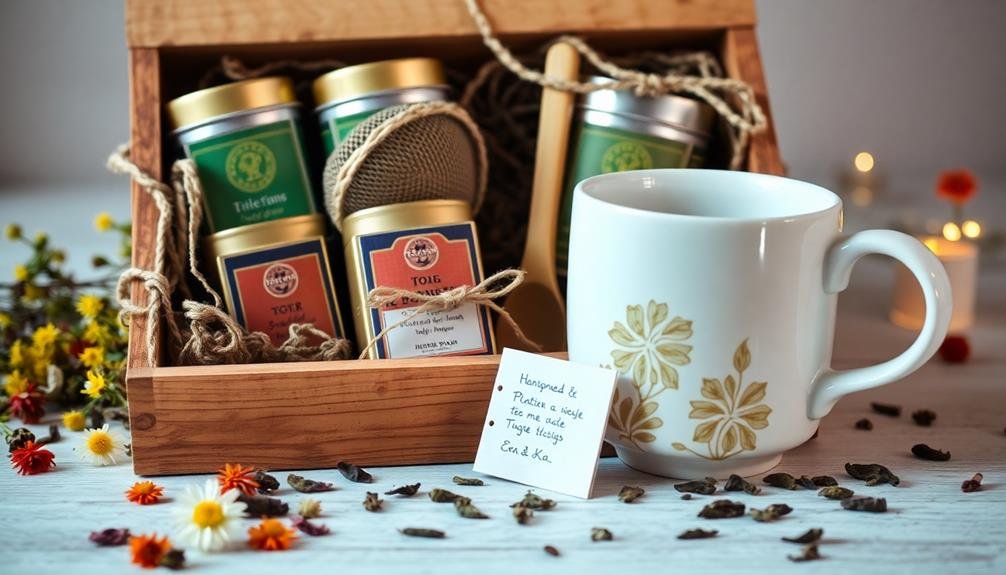
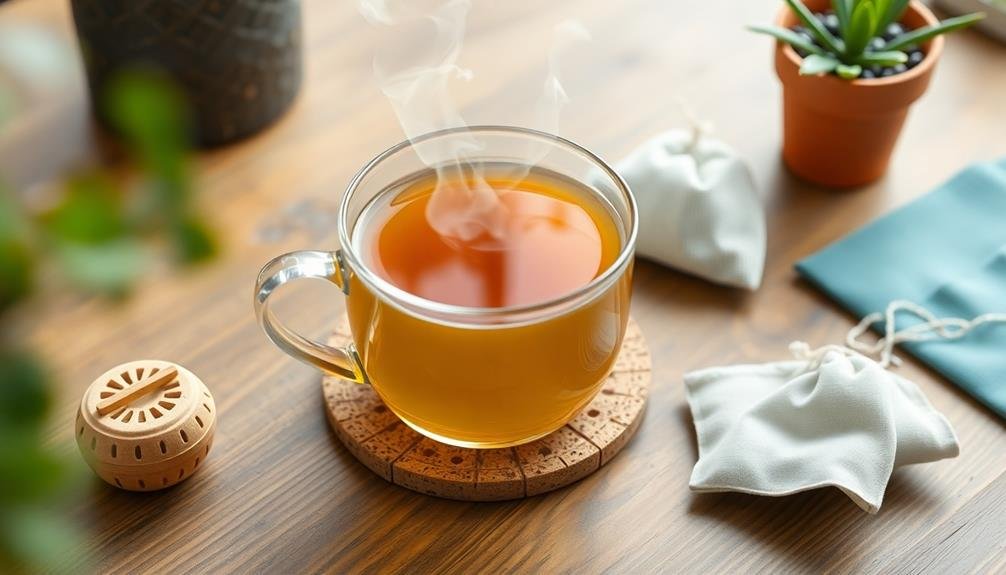
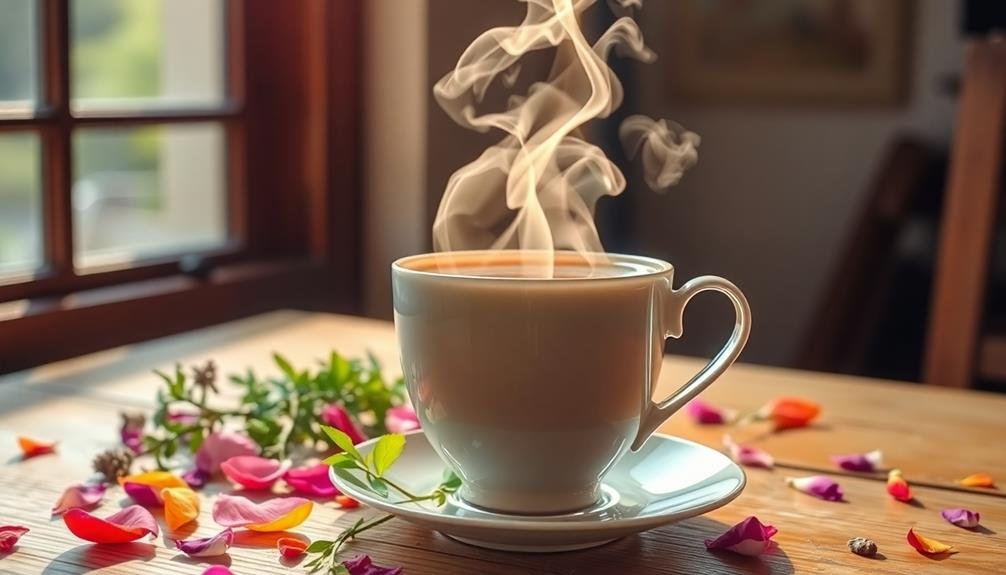
Leave a Reply